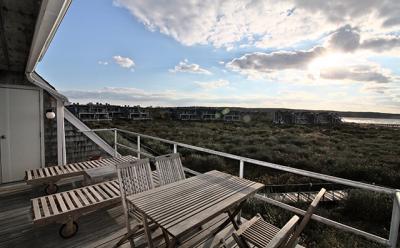A Studio by the Bay

Well, it’s not a shoe box exactly. But Barbarajo Howard’s one-room Montauk condominium certainly is small — officially, 483 square feet, or 683 if you count the balcony deck that runs the entire width of her top-floor apartment in the 30-acre Rough Rider Landing development.
Yet confined it’s not. It’s in one of the development’s three-tiered buildings with multiple balconies that are set back farther as they get higher, a fairly common feature in locations with sweeping views. The complex was built in the late 1980s after considerable controversy and concessions to meet local environmental concerns. The architect, Gary Cannella, created 21 buildings with 147 apartments, all with full balconies facing Fort Pond Bay. Their views, over greenery protected by raised walkways, are spectacular, with the bay’s far (western) side the Hither Hills State Park.
Clearly Albert Barone, the developer, had a keen eye for a site, even though he had to surmount the difficulties of building over low-lying land that once held the old fishing village of Montauk, which was swept away by the Hurricane of 1938. All the buildings start on the second floor, the ground level or first floor consisting of poured concrete units that support those above and hold heating and air-conditioning equipment. They are enclosed in walls of wooden lattice so storm waters can rush right through. With good luck, the buildings will survive.
“Everyone who lives here says their view is the best,” Ms. Howard said, “including me.” She added that a hobby of most residents is taking photographs of the ever-changing sunsets, the angles of which noticeably move right or left with the changing seasons as the earth’s orbit puts the sun in a slightly different part of the sky.
Ms. Howard has arranged every inch of her tiny apartment to take advantage of the giant view. She has relished the sweep of Montauk’s open spaces ever since she began going there in the summer, staying just down the beach from her present home at the Port Royal motel, which is now a condominium complex as well. She bought the studio in 2001 after the 9/11 terrorist attacks rained debris on her New York City apartment, and she began looking for a way to live in the area permanently. That dream came true when she leveraged her experience in public relations into her present job as director of marketing and communications at Guild Hall in East Hampton.
A complete view-centric renovation followed her purchase. She completely covered one wall with mirrors, extending them behind the sink in the kitchen area so both the cook (“I cook a lot,” she said) and her guests can see a reflection of the panorama even when seated at the small kitchen counter with their backs turned. She replaced a rough-textured ceiling with plaster, the better to blend with the brightness from a large skylight in the high ceiling. She eschewed curtains (“I like to see the stars at night”). She made sure her bed, couches, and even the small backs of the tall chairs at her kitchen counter are off-white to match the paint on the walls.
The only visual competitors with the view are a faintly Asian armoire by her bed concealing a small TV, a dark wood coffee table between the two couches, decorated by an off-white ceramic tray she made at the nearby Edward Albee Foundation studio, and a photograph and two drawings by her late mother, an artist, the largest of which is a Picasso-esque drawing that is mostly white space.
Ms. Howard’s artistic family background, she said, influenced her choices of décor. Another helpful influence was having grown up spending summers aboard a 40-foot sailboat, where small cabin space dictates that every item is stowed in precisely chosen locations. (The apartment has a built-in “California” closet with drawers, where she keeps scripts from her local acting career.) The Web has helped her minimalism, too. She keeps all her books on her Kindle and streams her music from the cloud. For all that, she says the apartment sleeps eight during family visits — two on the standard double bed, two on each of the couches, which convert to beds when the coffee table is folded and pushed back, and in a pinch, two more on blow-up floor mattresses.
Ms. Howard said she makes one concession to tight living by renting one of the development’s storage lockers near the beach. There, she keeps three bicycles, two paddleboards, and, in winter, cushions for the four chairs and two chaise longues that go with a small dining table on her balcony.
“Living small allows one to live large,” she said. “It frees up space in one’s life for doing stuff rather than maintaining it.”
